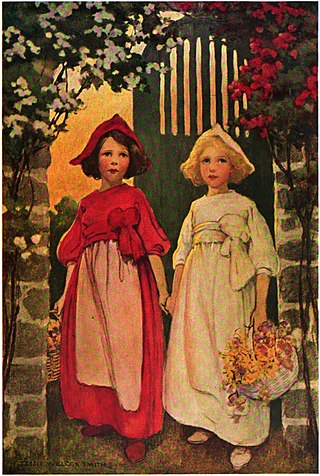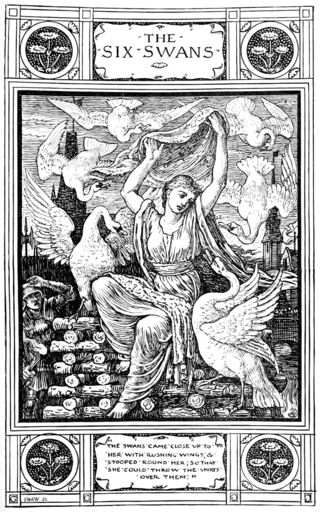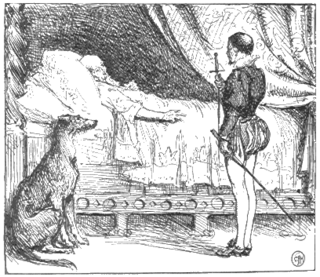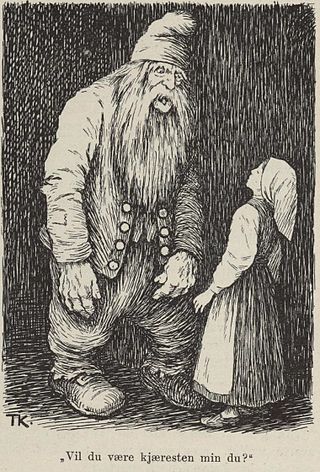"The Little Green Frog" (French : La Petite Grenouille Verte) is a French literary fairy tale, from the Cabinet des Fées . [1] Andrew Lang included it in The Yellow Fairy Book .
Two kings, Peridor and Diamantino, were cousins and neighbors, and the fairies protected them, until Diamantino behave so badly to his wife Aglantino that they would not let him live. His daughter Serpentine was his heiress, but as she was a baby, Aglantino became regent. Peridor loved his wife, but was so thoughtless that for punishment, the fairies let his wife die; his only comfort was his son, Saphir.
The fairies put a mirror into Saphir's bedroom, and it showed not his own face, but a beautiful girl. He fell in love. After a year, he saw she had a like mirror, and though he could not see the man reflected in it, he became jealous.
His father had grown more grief-stricken with time, until it was feared he would die. A gorgeous bird appeared at his window one day, and he felt well again, but the bird vanished. He offered a great reward, but no one could find it. Saphir set out in quest. In the forest, while thirsty, he came on a fountain and took out a cup to drink, but a little green frog kept jumping in his cup. It told him to drink and then to talk with it, because it knew of the bird.
It directed him to a castle, and told him to put a grain of sand in front of its gates. This would put everyone to sleep. He should go straight to the stable and take the horse. He obeyed until he reached the horse, when he thought it should have a harness as well, but when he laid hands on it, everyone woke. The lord took a fancy to him and let him go, and he returned to the frog.
After he convinced it of his regret, it sent him back with a grain of gold, and told him to find a room and take off a maiden there, without heed to her resistance. He obeyed until she asked to put on a dress first; this woke them all, and only by the fairies' intervention was he freed.
The frog sent him back with a grain of diamond and told him to find the garden, and cut off the branch with the bird he sought on it. This time he obeyed, and when he returned, he found a little rustic palace, with the maiden he had seen in the mirror. She told him that she had long admired him but never dreamed that he could see her. She told him that she had been the frog; that her name was Serpentine, and she knew nothing else of her family; and that fairies had raised her. She refused to marry him because he was a prince and she could not name her family.
A fairy arrived, to tell them the truth, and bring Aglantino to them; then she carried them to Peridor's castle. The bird proved to be Constance, and Saphir and Serpentine were married.
This is a standard medieval style fairy tale, complete with royalty, benevolent fairies, frogs (a symbol of disgust also used in The Frog Prince), and castles.
The gem analysis points out the recurring themes of precious gems and the use of gemology and mineralogy to make points.
The names reflecting peridot and sapphire are purely for effect, but serpentine is unusual as it is dark, not a gemstone or particularly valued, and it is associated with serpents. The connection may be to prime readers for the amphibian transformation, as to children both frogs and snakes are considered slimy, disgusting 'creepy crawlies'. Going up in value, sand we all know to be worthless, and gold is not a gemstone, so the diamond will obviously work (also making it that three is magic, an old belief common to fairy tales). That Serpentine's royal father's name means diamond is linking her proven royal heritage with the stone, as they are in the story, chronologically.
The place of the mysterious bird, Constance, is unclear and seems to reflect another mythology or a related tale. It does not seem to fit as a fairy or a gem, but fits the magical setting.
Under this lens, the tale is parallel to other European fairy tales classified as Aarne–Thompson–Uther ATU 550, "The Quest for the Golden Bird", as pointed by folklorists Johannes Bolte and Jiří Polívka. [2]
The Brothers Grimm themselves, in the annotations to their tales, noted that the anonymous tale of La petite grenouille vert was "visibly related" to their tale "The Golden Bird". [3] [4]

"Snow-White and Rose-Red" is a German fairy tale. The best-known version is the one collected by the Brothers Grimm in 1837 in the third edition of their collection Grimm's Fairy Tales. It was first published by Wilhelm Grimm in 1827 in Wilhelm Hauff's Märchen-Almanach. An older, somewhat shorter version, "The Ungrateful Dwarf", was written by Caroline Stahl (1776–1837). Indeed, that appears to be the oldest variant; no previous oral version is known, although several have been collected since its publication in 1818. Oral versions are very limited regionally. The tale is of Aarne-Thompson type 426.

"The Six Swans" is a German fairy tale collected by the Brothers Grimm in Grimm's Fairy Tales in 1812. It is of Aarne–Thompson type 451, commonly found throughout Europe. Other tales of this type include The Seven Ravens, The Twelve Wild Ducks, Udea and her Seven Brothers, The Wild Swans, and The Twelve Brothers. Andrew Lang included a variant of the tale in The Yellow Fairy Book.

"Jorinde and Joringel" is a German fairy tale collected by the Brothers Grimm. It is Aarne–Thompson 405. The tale is found virtually exclusively in Germany, barring a Swedish variant, although Marie Campbell found a variant in Kentucky, "The Flower of Dew". The story is known in many English translations as "Jorinda and Jorindel".

"The Golden Bird" is a fairy tale collected by the Brothers Grimm about the pursuit of a golden bird by a gardener's three sons.

The Iron Stove is a fairy tale collected by the Brothers Grimm, as tale number 127. It is Aarne–Thompson type 425A, "The Animal (Monster) as Bridegroom". Dorothea Viehmann prepared the story for the Grimms' collection.

"Trusty John", "Faithful John", "Faithful Johannes", or "John the True" is a German fairy tale collected by the Brothers Grimm and published in Grimm's Fairy Tales in 1819. Andrew Lang included it in The Blue Fairy Book.
How the Devil Married Three Sisters is an Italian fairy tale found in Thomas Frederick Crane's Italian Popular Tales (1885). It was collected and originally published in German as "Der Teufel heirathet drei Schwestern" by Widter and Wolf in 1866.

"Fitcher's Bird" is a German fairy tale collected by the Brothers Grimm, tale number 46.
"The Three Little Birds" is a German fairy tale collected by the Brothers Grimm, tale number 96. The story is originally written in Low German. It is Aarne-Thompson type 707, the dancing water, the singing apple, and the speaking bird. The story resembles Ancilotto, King of Provino, by Giovanni Francesco Straparola, and The Sisters Envious of Their Cadette, the story of the 756th night of the Arabian Nights.

"Donkey Cabbages" is a German fairy tale collected by the Brothers Grimm, tale number 122. A man shoots birds in a forest and gains magical objects. By also ingesting the heart of one of the birds he shot, he acquires an inexhaustible source of wealth. Later on, his magical abilities and items are stolen by a trio of witches, but he regains everything thanks to a magical herb that causes one to transform into a donkey.

The Bee and the Orange Tree is a French literary fairy tale by Madame d'Aulnoy.
"The Brown Bear of the Green Glen" is a Scottish fairy tale collected by John Francis Campbell in Popular Tales of the West Highlands, listing his informant as John MacDonald, a "Traveling Tinker". He also noted the parallels with The Water of Life.
The Wicked Sisters is a Russian fairy tale collected by Alexander Afanasyev in Narodnye russkie skazki.
"The Three Languages" is a German fairy tale collected by the Brothers Grimm, tale number 33. It is Aarne-Thompson type 671.
"Thumbling," published in German as "Daumesdick" is a German fairy tale collected by the Brothers Grimm in Grimm's Fairy Tales in 1819. The Grimms included another, similar story, "Thumbling's Travels." Both stories are related to the English Tom Thumb and often share its title when translated into English.

"The Peasant's Wise Daughter", "The Peasant's Clever Daughter" or "The Clever Lass" is a German fairy tale collected by the Brothers Grimm in Grimm's Fairy Tales as tale number 94. It has also spread into Bohemia and Božena Němcová included it into her collection of Czech national folk tales in 1846.

"The Old Dame and her Hen" is the English title given by Dasent to the Norwegian folk tale, Asbjørnsen and Moe’s number 35.
The Dragon is an Italian literary fairy tale, included in Giambattista Basile's Pentamerone, first published 1635. In the English language, the tale was a selection in Thomas Keightley's Fairy Mythology (1828), and later appeared in John Edward Taylor 's translation of the entire work, The Pentamerone, or, The Story of Stories, Fun for the Little Ones (1848). The tale has been classed as a version of Aarne–Thompson type 462 "the outcast queens and the ogress queen", rather than as "the dragon-slayer". It exhibits folklore motif K873, "fatal deception by giving narcotic."
Tulisa, the Wood-Cutter's Daughter is an Indian legend published as an annex to Somadeva Bhaṭṭa's work, related to Cupid and Psyche.
"Thumbling's Travels" is a German fairy tale collected by the Brothers Grimm in Grimm's Fairy Tales in 1812. The original German name for the character is "Daumerling," not to be confused with the similar tale "Daumesdick" or KHM 37, which was added in 1819. Both tales are frequently translated into English as "Tom Thumb" or "Thumbling" and are categorized as Aarne-Thompson type 700.